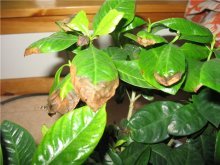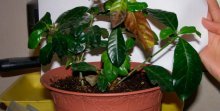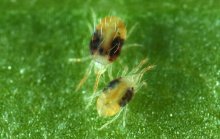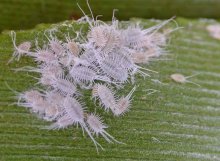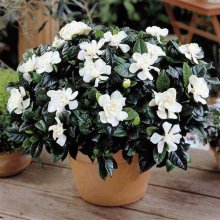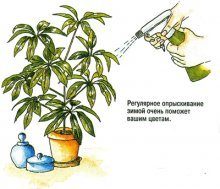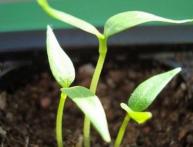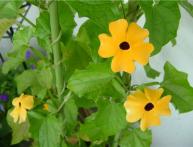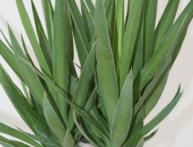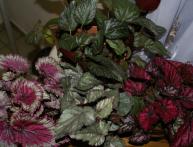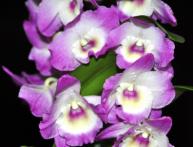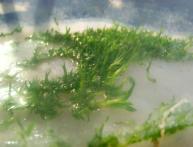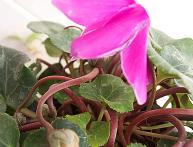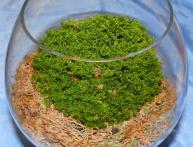Gardenia leaves turn black and fall off, what to do, care rules
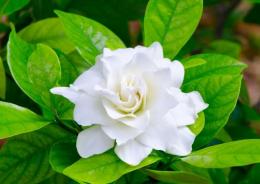
Most gardeners will not hesitate to call gardenia their favorite. This is because it is valued for its spectacular flowering. In addition, it has beneficial and medicinal properties.
Gardenia is a rather capricious plant that is susceptible to various diseases and pest attacks. Failure to care for it can lead to illness and loss of decorativeness. The article will tell you about indoor plants gardenias, features of caring for it, why its leaves turn black and fall off and about the pests to which it is susceptible.
Content:
Description of the plant
Gardenia is a heat-loving plant that grows in the south. Demanding about the conditions of his detention. Growing this decorative indoor flower is very troublesome.
It’s not uncommon for flower growers to take a risk by buying it for their winter garden, but the time and effort spent on care does not go unrewarded. He thanks his owner with a long and abundant flowering.
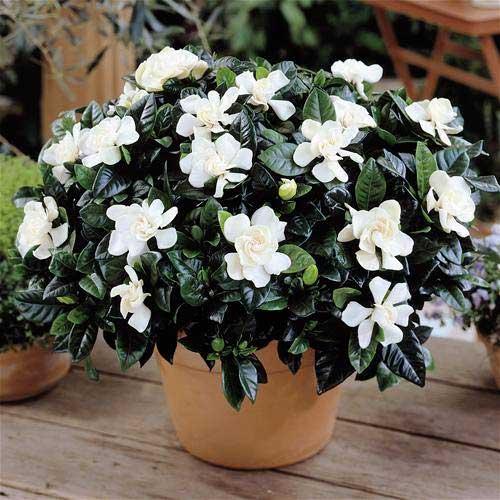
The plant responds very violently to any external stimuli and care features. The cause of the disease can be improper watering, poor lighting, low temperature in the room where the flower is located, low humidity and many other reasons.
With any disease, the plant loses its decorative effect. Him turn yellow and the leaves dry out, and in some cases even turn black, and the buds fall off.
Features of cultivation
The plant is quite demanding in terms of maintenance conditions. Beginner gardeners may encounter difficulties caused by watering, lighting, fertilizing, the composition of the soil for replanting.
Gardenia does not tolerate being moved from one place to another; you cannot even turn the pot, because the leaves and buds may begin to fall off.
Important!!! The plant must be provided with all the conditions necessary for a comfortable existence. If this is not done, quality development and long-term flowering you can never wait.
Diseases
Let's look at the most common diseases to which gardenia is susceptible, and find out when its leaves turn black and fall off.
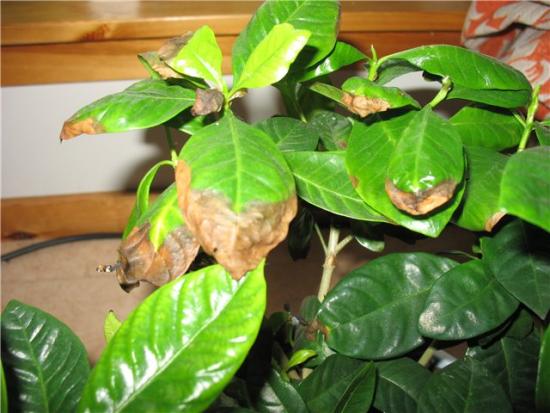
Incorrect watering mode
Yellowing of leaves often occurs when the soil is too wet or dry out. Water the flower is necessary as soon as the soil dries to a depth of 3-4 centimeters. This depends on the size of the container and the size of the plant. You cannot wait for the soil to dry completely.
Water quality also plays an important role. It can easily cause the foliage to dry out. Only filtered or well-settled water, which should always be warm, is suitable for the flower. Do not use hard water.
Incorrect soil mixture
Flower prefers acidic soil, all the rest will provoke its diseases, because the roots in them will not be able to provide adequate nutrition to the plant.
Soil with an acidic pH value can be purchased at a specialty store. It’s called “Gardenia”, “Azalea” will also do. You can acidify the substrate by adding pine needles to it.
To prevent alkalization of the soil, gardenia can be watered once a decade with water, which must be acidified by dissolving citric acid in 1 liter of water, taking it on the tip of a knife. It can be replaced with 2-3 drops of lemon juice.
You can also use oxalic acid by dissolving 1/3 teaspoon in 3 liters of water, it must stand for several days to allow calcium salts to settle, they are harmful to many indoor colors.
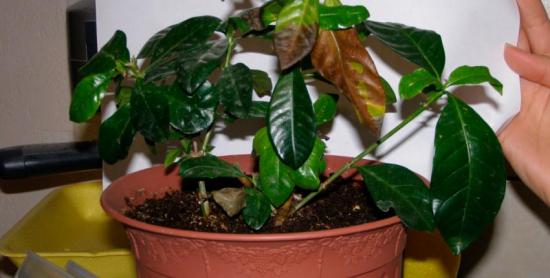
Chlorosis
This disease can be identified by pale turning yellow leaves and bright veins. It is associated with iron deficiency in the soil. This disease can be called chronic, and you need to fight it constantly.
This pathology develops due to alkalization of the soil. Its excellent prevention is watering with water with added acid. When signs appear, the plant should be sprayed and watered with preparations with a high iron content; you can also improve the situation by burying several nails in the pot.
Lack of lighting
Insufficient lighting often causes yellowing and drying of foliage. This happens evenly throughout the plant.
Malnutrition
Like any indoor flower, gardenia requires feeding during active growth and the onset of the flowering period. It requires choosing a balanced fertilizer that contains a lot of magnesium and iron.
Spraying the plant with magnesium sulfate helps to revive the plant, accelerate and enhance its flowering. The spraying solution is prepared at the rate of 2 grams of substance per 1 liter of water.
Draft and frostbite
Gardenia is a delicate and capricious plant. Temperature jumps in any direction cause blackening leaves.For this plant, the optimal temperature is 18-24 degrees Celsius.
Low air humidity
This plant came to our windowsills from the humid tropics. It loves high air humidity, otherwise it begins to drop buds. To humidify the air around the gardenia, the pot with it should be placed in a tray with wet expanded clay. The leaves of the plant will collect the moisture that comes from the expanded clay.
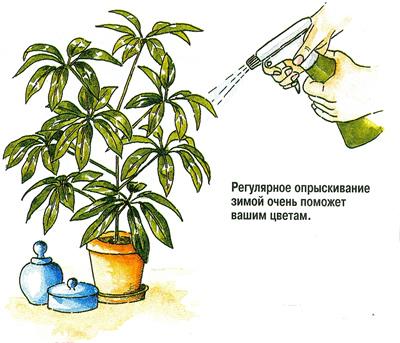
You can resort to using a humidifier or spraying. Only when spraying should you not get it on the buds and flowers.
Change of place
Rotating a flower with buds around its own axis is strictly not recommended. True, some species tolerate this normally, but others drop flowers and buds.
Untimely transplant
This indoor plant can be replanted only after flowering. If transplant a plant with buds - it will simply drop them.
Pests and ways to combat them
In addition to diseases, gardenia is susceptible to attacks by various pests.
White aphid
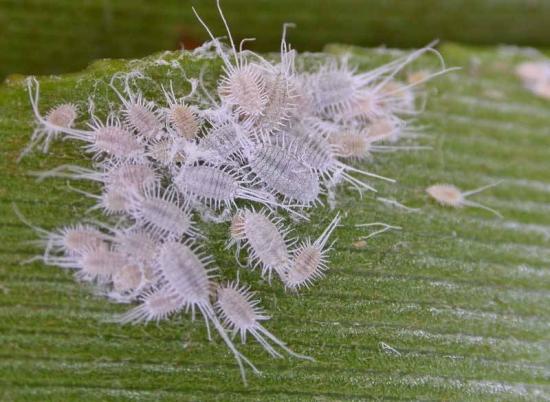
A harmful insect that attacks the stems and foliage of plants. This is often the reason why buds fall off. You need to know that this insect reproduces very quickly. When it appears, immediate action must be taken to destroy it. pests.
Spider mite
This is the main enemy of the tropical beauty. Along with it, the plant is also threatened by the scale insect.
To get rid of pests, it is necessary to periodically wipe the leaf plates with a napkin or cotton pad soaked in water.
This will help ensure comfortable air humidity around the flower and detect the presence of pests and their larvae.
If shoots affected by arachnoid are detected tick they must be removed immediately.This pest attacks flowers when the humidity in the room where they are located is too low. For preventive purposes, they need to be sprayed regularly.
If the pest appears, it is necessary to treat the leaves with special insecticides. This will rid your gardenia of spider mites for a long time.
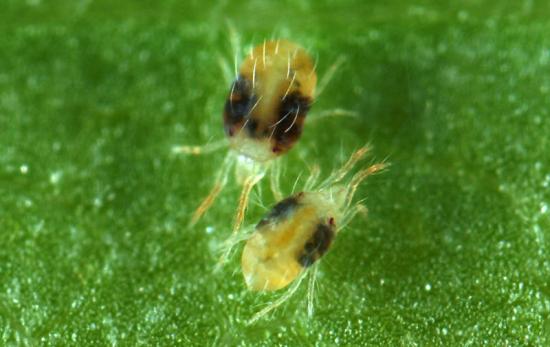
Shchitovka
To combat scale insect Washing the leaves with a mild soap solution works great. For greater effectiveness, you need to repeat the treatment after a week. To avoid infection of other plants, affected plants must be isolated.
Let's watch a video about proper gardenia care:

